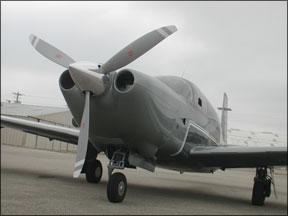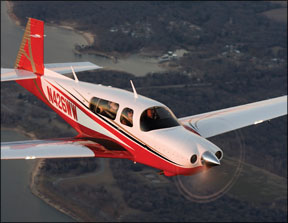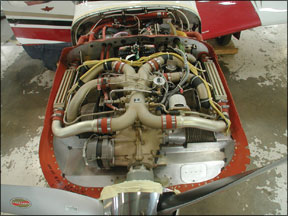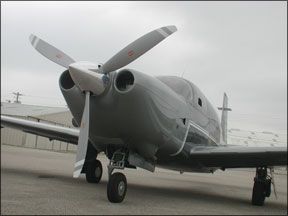Just as there will always be an England, there will always be airplane buyers to whom nothing else matters but raw speed. Forget cabin size, payload, range or safety-lets just go faster than anyone else. And for these buyers, Mooney has just the airplane-the new Acclaim Type S, which appears to us to be a no-kidding 240-knot-plus airplane, making it the fastest single-engine piston currently in production-no arguments. Although speed is the antithesis of efficiency, the Type S can, nonetheless, deliver its blazing speed at relatively economical fuel burns. Mooney got into a marketing spat last year with the then Columbia Aircraft (now Cessna) about who had the fastest single. We think we settled this in our October 2007 report in which we found the Mooney Acclaim easily got past the Columbia in a two-way speed trial. If there was any doubt then, there isn’t now. At realistic cruise speeds and equivalent fuel flows, the Type S is solidly 20 knots faster than the Columbia and maybe a bit more than that over the Cirrus SR22 TN. Howd they do that? Mainly through a series of drag tweaks-flap hinge and gap treatments, new nosegear doors, redirection of cowl exit air, removal of the cabin entry step and an optimized prop. In our experience, speed mods like these often deliver elusive benefits. If one or two knots is promised, you may see a needle nudge or nothing at all. But Mooney seems to have genuinely delivered five knots over the 237-knot top speed claimed for the Acclaim. We never confirmed that number for the Acclaim, by the way, but the Columbia fell far enough short of the Mooneys performance to make the Acclaim the winner in our speed flyoff last year.
Go Fast
The Acclaim first appeared in late 2006, marketed as a high-performance, high-altitude cruiser for the discerning speed aficionado. Riding the coattails of Cirrus huge success with its Tornado Alley Turbo turbonormalized SR22, Mooney at first called the Acclaim turbonormalized. It really isn’t. It has a TSIO-550-GN that ground boosts slightly and, in any case, has the 7.5 to 1 compression ratio pistons Continental has used to build in detonation margins into turbocharged engines.
The Cirrus TN uses the IO-550 too, but with 8.5 to 1 pistons, which gives it a slight thermal efficiency edge. Mooneys version of this engine is derated to 280 HP, while the Cirrus generates the fully certified 310 HP.
With the Acclaim barely out the gate, Mooney chief engineer Dan Apel set to work looking for drag to lose, which he hunted down not in the wind tunnel but by computer numerical analysis and intuition.

We first heard rumors of the 240-knot-plus Mooney last fall and saw our first example at Sun n Fun in April.
Subtle Mods
We expected to see the Acclaims yawning cowl intakes reduced in size, but they arent. You have to look closely to see the airframe mods-like crawling under the wing and lying on your back to examine the underside of the flaps. Six of the eight fairings on the flap hinges have been removed and the gap has been reduced noticeably.
Although Apel told us the tradeoff is a slightly higher stall speed-about a knot-there’s still margin against the 61-knot certification limit. (The Type S POH lists the Vso as 60.2 knots, In the original Acclaim, its shown as 59 knots.)
The nosegear doors have an improved articulation for a tighter seal and theyre made of lighter carbon fiber than the original Acclaims metal doors. Although the cowling itself is carbon fiber, Mooney added some metal air diverters to clean up turbulence where the cooling exits the cowl. Apel compares to the down-force wings on open-wheel race cars-they clean up drag-inducing turbulence where the air exits the cowling.
Still, there are massive round inlets on the top cowl. Wouldnt the addition of adjustable cowl flaps allow smaller inlets and less cooling drag? Maybe, says Apel. But the cowl flaps would add weight and complexity and the performance gain might not be worth the effort. Clearly, the Type S has excess cooling air in cruise flight, but not in climb, where we saw CHTs pushing above 420 degrees on two cylinders. A shallower climb and boost-pump enriched fuel flow addresses this, but Acclaim pilots need to pay attention to CHTs, especially on hot days.

The original Acclaim had a Hartzell three-blade prop and so does the Type S, but its chord and section have been reshaped to provide the best thrust/drag optimization at high altitude, where the airplane will spend most of its cruise time. Type S gains a little climb and runway performance from this tweak, but the POH doesnt claim it. It does show 100 feet of landing roll out penalty due to the higher stall speed. This is so minor as to be erased by variables in pilot technique.
Mooney pilots have, from time to time, debated the drag penalty of the cabin step, which is located on the underside of the fuselage inboard of the right flap. It costs about a knot, says Apel, so the Type Ss is removable for the demanding pilot who simply insists on every last iota of cruise speed. While entering the cabin without the step is doable, we would rather have it than not, to protect against the flap being used as a step by clumsy passengers.
Flying It
We flew the Type S with Mooneys Dave McGee on a gusty Kerrville day with temperatures 12 degrees above ISA at altitude. The example we flew had neither TKS nor air conditioning, so we expected top performance. With two aboard and full fuel (89 gallons usable in the demo we flew; most owners opt for the 102-gallon optional capacity) our takeoff weight was about 3309 pounds or about 2 percent under the airplanes 3368-pound allowable gross weight.
We were interested in three things: Does the Type S deliver on its speed claims (yes), are the speed claims practical (yes) and does it do these things without frying the cylinders? Generally yes to that last question, but we don’t agree with Mooney and Continental on CHT limits, which allow maximum continuous temperatures as high as 460 degrees F. Fortunately, the Type S has sufficient air flow to keep the CHTs in line, with proper technique.
For our flight trials, we used data from the onboard Garmin G1000 system and we reduced data from the steam gauges. We applied the air data correction data published in the AFM. We conducted climb and cruise trials to 8000, 12,000, 17,000 and 25,000 feet, the airplanes certification maximum.
The Type S is no slouch down low and it gets there quickly. Initial climb rates were in the 1200 to 1500 FPM range and the airplane will sustain 900 to 1100 FPM all the way to 25,000 feet, without undue CHT stress. The chart above reveals some of the numbers. As is typical of turbocharged airplanes, low-altitude performance is good, but not as efficient as going higher usually is. Into a stiff winter headwind, 12,000 feet is a good compromise and there the Type S cruised at 203 knots, burning 17.2 GPH lean of peak or 21.8 GPH and 212 knots on the rich side. In the high-teens profile-another favorite of many owners-we trued at 212 knots and 17.5 GPH lean and 225 knots on 21.6 GPH rich. This performance conforms closely to the POH claims and at the lower altitudes, the Type S is faster than both the Cirrus TN and the Cessna 400.
Higher, the Type S gets serious. Flat out at 25,000 feet, burning 21.5 GPH on the rich side, we recorded 242 knots true, corrected for airdata errors. Even leaned to 16.1 GPH, the airplane boiled along at 228 knots, leaving the Cirrus in its fumes on both speed and efficiency. This last observed speed is somewhat higher than the POH predicted, so its possible we didnt allow the airplane to settle down long enough. In any case, the 220 knots on 15 to 16 GPH is realistic.
CHT wise, we didnt like the 410 to 415-degree temps we recorded while running at the recommended 50-degrees rich of peak for best power. Although Continental and Mooney authorize this, we wouldnt do it in an airplane we owned-we think temperatures in that range are just too warm to sustain. Long term owner experience may shed light on this, but given troubles owners have experienced with Continental cylinders, we would prefer the lean-of-peak strategy. And after all, isn’t 222 knots fast enough?
Pulled back to 16 or 17 gallons, the engine remained smooth-with a slight rumble, perhaps-but the CHTs cooled nicely into the 350- to 380-degree range. Moreover, the lean setting extends endurance by more than an hour and at 220-plus knots, that adds up to an extra state crossed. McGee told us he leans in the climb to save fuel and avoid plug fouling, but we would run the low-boost on-as recommended above 12,000 feet or if TIT is above 1450 degrees and rising-and full rich.
Because the Type S climbs so fast, you’ll be at the highest cruise altitude in 30 to 40 minutes, so our view is that trading off a little extra fuel for the lower CHTs is worth it. We found that a full rich climb with the pump on knocks the CHTs below 400 degrees F.
Range, Payload
At these low-mach cruise speeds and low fuel flows, range is the Type Ss forte, even if payload isn’t. It carries 89 gallons of gas, all usable, so with a rapid climb to altitude and 45-minute reserve, figure about 930 miles of still-air range, which is a little over a four-hour leg in this airplane.
But don’t plan on carrying friends. Useful load in the example we flew was 938 pounds, leaving about 404 pounds for people and bags, with full fuel. Add TKS (90 pounds) and air conditioning (65 pounds) and youre down to an airplane that will carry one stout pilot and some bags, with full gas.
But thats Mooneys niche-speed in a small cabin that carries a modest load. If you want to carry more, buy a Saratoga or a Beech 36, both with six seats. The Cirrus and Cessna 400 do a little better on payload against range, but not much with like equipment.
Equipment, Options
The Type S has essentially the same equipment and option list as the Acclaim had, as shown in the chart at left. The significant exception is a Garmin G1000 upgraded to WAAS and with a new detailed engine monitor page on the MFD side.
The introductory Acclaim had only an engine summary page-which the new airplane still has-but the expanded version shows spiffy electronic analog gauges for MAP, fuel flow, RPM and temps and lucid bar charts for EGT and CHT, plus some built-in warning functions. The G1000 will have Garmins new synthetic vision along with the HITs display found in the new Cirrus.
How useful the WAAS upgrade is will vary by flying style. When we returned to Kerrville after our demo with Dave McGee, the weather had tanked to a lowish overcast and having a WAAS approach with vertical guidance and a low HAT was certainly welcome.
Practicalities
So, is this really a 242-knot airplane? While it will deliver that impressive number, its not practical to fly it that fast, in our view. At 21.5 GPH, the airplane will have short legs with the 89-gallon standard fuel load and even a minimal reserve of say 45 minutes. Figure under three hours-but less in real weather, when you’ll want a fatter reserve. Also, as noted, we don’t like those high CHTs on a sustained basis. With 102-gallon tanks, it does better.
But pulled back to 16 to 17 GPH, the airplane has a 900-mile-plus range carrying two people and light bags. If you limit yourself to the high teens-which we think is smart-and fly a max economy profile at 15 GPH, the airplane will fly 200 knots for more than four hours at better than 13 MPG. Best case, for the truly efficiency minded, it will do 190 knots on 11.3 gallons or nearly 17 MPG with a still-air range of nearly 1200 miles.
What most impresses us about the Type S is not its raw speed, but that Mooney was able to eke meaningfully more speed out of an airframe thats decidedly old school. Cirrus and Cessna/Columbia represent state-of-the-art composite design and construction, yet when the comparisons are reduced to the basics, the Mooney bests the other two on speed and range, but lags on payload and cabin comfort. Thats impressive in the absolute, but especially when you consider that the Acclaims type certificate dates to the 1960s.





